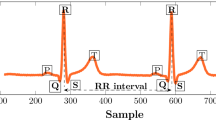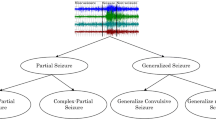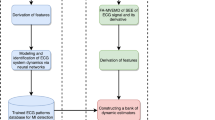Abstract
This article proposes a selection method that can be applied to choose the best parameters to classify contractions in the uterine electrohysterography (EHG) signal for the detection of preterm labor. Several types of parameters have historically been extracted from the electrohysterogram. These can be divided into three classes: linear parameters, nonlinear parameters and parameters related to the electrohyterogram propagation. Frequency band enhancement EHG characterization has also been extensively studied. Our work is divided in two parts. The first part is to implement and compute all the parameters already extracted from the EHG that have been published in the literature. These parameters were computed both on the original EHG and on different frequency bands obtained using wavelet packet decomposition. In the second part, we will use a new parameters selection method to eliminate all parameters that are not efficient and pertinent for classification. Our results indicate a set of 13 linear parameters, 3 nonlinear parameters and 2 propagation parameters that are potentially most useful to discriminate between pregnancy and labor contractions, either on different frequency bands or directly on original EHG.




Similar content being viewed by others
Abbreviations
- a :
-
Degree of polynomial function
- \(\alpha \) :
-
scaling exponent alpha
- B :
-
Number of bins of histogram
- C :
-
Constant
- \(C_{m}\) :
-
number of pattern matches
- D1, D2, D3, D4, D5, D6, D7, D8 and D9:
-
Deciles
- D5:
-
Median frequency
- DFA:
-
Detrended fluctuation analysis
- \(D_{Je} \left( {H,G} \right) \) :
-
Jeffrey divergence
- \(\Vert \Delta _{{d}_0 } \Vert \) :
-
Euclidean distance between two states of the system to an arbitrary time \(t_0 \)
- \(\Vert \Delta _{{d}_{t}} \Vert \) :
-
Euclidean distance between the two states of the system at a time later \(t\)
- EHG:
-
Uterine electrohysterographic signal, electrohysterogram
- F(n):
-
Fluctuation function
- \(f(x_{u})\) :
-
Linear piecewise approximation of the nonlinear regression curve
- FNN:
-
False nearest neighbors
- \(\varPhi _{x}(t)\) :
-
Unwrapped phases of the signals x
- \(\varPhi _{y}(t)\) :
-
Unwrapped phases of the signals y
- \(\varphi _{e,f} \) :
-
Phase synchronization principle
- \(\gamma _{e,f}\) :
-
Phase synchronization called “mean phase coherence”
- \(H=\{h_{z}\}\) and \(G=\{g_{z}\}\) :
-
\(H\) and \(G\) are the two histograms
- \(H^{2}\) :
-
Nonlinear correlation coefficient
- IF:
-
Instantaneous frequency
- LE:
-
Lyapunov exponent
- m :
-
Length of sequence
- MPF:
-
Mean frequency
- n :
-
Length of box
- N :
-
Length of the signal
- p :
-
Number of sliding windows
- PF:
-
Peak frequency
- PL:
-
Preterm labor
- \(\hbox {PSD}, S_{x}(f)\) :
-
Power spectral density
- r :
-
Tolerance for accepting
- \(R^{2 }\) :
-
Linear correlation coefficient
- SE:
-
Sample entropy
- threshold1:
-
Mean+1*standard deviation
- threshold2:
-
Mean+2*standard deviation
- Tr:
-
Time reversibility
- \(\tau \) :
-
Time delay
- VarEn:
-
Variance entropy
- Vb7:
-
Bipolar channel 7
- Vb8:
-
Bipolar channel 8
- Vbi:
-
Vertical bipolar signals
- W1, W2, W3, W4 and W5:
-
Variances on the five selected detail levels
- \(X\left( k \right) \) :
-
New integrated series
- x :
-
EHG bipolar channel Vb7
- \(x_{l}\) :
-
l-th segment of \(x\)
- \(\overline{x}\) :
-
Mean of x
- y :
-
EHG bipolar channel Vb8
References
Neonatal and perinatal mortality: country, regional and global estimates; Report WHO 2006. http://whqlibdoc.who.int/publications/2006/9241563206_eng.pdf
Maner, W.L., Garfield, R.E., Maul, H., Olson, G., Saade, G.: Predicting term and preterm delivery with transabdominal uterine electromyography. Obstet. Gynecol. 101(6), 1254–1260 (2003)
Devedeux, D., Marque, C., Mansour, S., Germain, G., Duchêne, J.: Uterine electromyography: a critical review. Am. J. Obstet. Gynecol. 169(6), 1636 (1993)
Maner, W.L., Garfield, R.E.: Identification of human term and preterm labor using artificial neural networks on uterine electromyography data. Ann. Biomed. Eng. 35(3), 465–473 (2007)
Marque, C.K., Terrien, J., Rihana, S., Germain, G.: Preterm labour detection by use of a biophysical marker: the uterine electrical activity. BMC Pregnancy Childbirth 7(Suppl 1), S5 (2007)
Marque, C., Duchene, J.M.G., Leclercq, S., Panczer, G.S., Chaumont, J.: Uterine EHG processing for obstetrical monitorng. IEEE Trans. Biomed. Eng. 12, 1182–1187 (1986)
Leman, H., Marque, C., Gondry, J.: Use of the electrohysterogram signal for characterization of contractions during pregnancy. IEEE Trans. Biomed. Eng. 46(10), 1222–1229 (1999)
Marque, C., Leman, H., Voisine, M.L., Gondry, J., Naepels, P.: Traitement de l’électromyogramme utérin pour la caractérisation des contractions pendant la grossesse. RBM-News 21(9), 200–211 (1999)
Sikora, J., Matonia, A., Czabanski, R., Horoba, K., Jezewski, J., Kupka, T.: Recognition of premature threatening labour symptoms from bioelectrical uterine activity signals. Arch. Perinat. Med. 17(2), 97–103 (2011)
Arora, S., Garg, G.: A novel scheme to classify EHG signal for term and pre-term pregnancy analysis. Int. J. Comput. Appl. 51(18), 37–41 (2012)
Diab, M.O., Marque, C., Khalil, M.A.: Classification for uterine EMG signals: comparison between AR model and statistical classification method. Int. J. Comput. Cognit. 5(1), 8–14 (2007)
Moslem, B., Khalil, M., Marque, C., Diab, M.O.: Energy distribution analysis of uterine electromyography signals. J. Med. Biol. Eng. 30(6), 361–365 (2010)
Radomski, D., Grzanka, A., Graczyk, S., Przelaskowski, A.: Assessment of uterine contractile activity during a pregnancy based on a nonlinear analysis of the uterine electromyographic signal. In: Information Technologies in Biomedicine. Springer, Berlin, 47(3), 325–331 (2008)
Ivancevic, T., Jain, L., Pattison, J., Hariz, A., et al.: Preterm birth analysis using nonlinear methods. Recent Patents Biomed. Eng. 1(3), 160–170 (2008)
Moslem, B., Khalil, M., Diab, M.O., Marque, C.: Detrended fluctuation analysis of uterine electromyography. Presented at the First Middle East Conference on Biomedical Engineering, MECBME11, Sharjah, UAE (2011)
Diab, A., Hassan, M., Marque, C., Karlsson, B.: Quantitative performance analysis of four methods of evaluating signal nonlinearity: application to uterine EMG signals. Presented at the 34th Annual International IEEE EMBS Conference. San Diego, USA (2012)
Hassan, M., Terrien, J., Alexandersson, A., Marque, C., Karlsson, B.: Improving the classification rate of labor vs. normal pregnancy contractions by using EHG multichannel recordings. Presented at the 32nd Annual International Conference of the IEEE Engineering in Medicine and Biology Society, Buenos Aires, Espagnol (2010)
Hassan, M., Alexandersson, A., Terrien, J., Muszynski, C., Marque, C., Karlsson, B.: Better pregnancy monitoring using nonlinear propagation analysis of external uterine electromyography. IEEE Trans. Biomed. Eng. 60(4), 1160–1166 (2013)
Fele-Žorž, G., Kavšek, G., Novak-Antolič, Ž., Jager, F.: A comparison of various linear and non-linear signal processing techniques to separate uterine EMG records of term and pre-term delivery groups. Med. Biol. Eng. Comput. 46(9), 911–922 (2008)
Terrien, J., Steingrimsdottir, T., Marque, C., Karlsson, B.: Synchronization between EMG at different uterine locations investigated using time–frequency ridge reconstruction: comparison of pregnancy and labor contractions. EURASIP J. Adv. Signal Process. 2010, 1–10 (2010)
Lucovnik, M., Maner, W.L., Chambliss, L.R., Blumrick, R., Balducci, J., Novak-Antolic, Z., Garfield, R.E.: Noninvasive uterine electromyography for prediction of preterm delivery. Am. J. Obstet. Gynecol. 204(3), 228.e1–228.e10 (2011)
Coifman, R.R., Wickerhauser, M.V.: Entropy-based algorithms for best basis selection. IEEE Trans. Inf. Theory 38(2), 713–718 (1992)
Khalil, M.: Une approche de la détection et de la classification dans les signaux non stationnaires. Application a l’EMG utérin. Ph.D. dissertation, Thèse de l’université de Technologie de Troyes, 1999. [Bin French]
Alamedine, D., Khalil, M., Marque, C.: Comparison of different EHG feature selection methods for the detection of preterm labor. Comput. Math. Methods Med. (2013, in press)
Hu, M., Liang, H.: Variance entropy: a method for characterizing perceptual awareness of visual stimulus. Appl. Comput. Intell. Soft Comput. 2012, 1–6 (2012)
Bhattacharya, J.: Reduced degree of long-range phase synchrony in pathological human brain. Acta Neurobiol. Exp. (Warsz.) 61(4), 309–318 (2001)
Rajaei, A., Dallalzadeh, E., Rangarajan, L.: Symbolic representation and classification of medical X-ray images. Signal Image Video Process. 1–11. doi:10.1007/s11760-013-0486-6
Rubner, Y., Tomasi, C., Guibas, L.J.: The earth mover’s distance as a metric for image retrieval. Int. J. Comput. Vis. 40(2), 99–121 (2000)
Ma, Y., Gu, X., Wang, Y.: Histogram similarity measure using variable bin size distance. Comput. Vis. Image Underst. 114(8), 981–989 (2010)
Terrien, J., Hassan, M., Germain, G., Marque, C., Karlsson, B.: Nonlinearity testing in the case of non Gaussian surrogates, applied to improving analysis of synchronicity in uterine contraction. Presented at the Engineering in Medicine and Biology Society: EMBC 2009. Annual International Conference of the IEEE, Minneapolis, USA, pp. 3477–3480 (2009)
Terrien, J., Marque, C., Germain, G., Karlsson, B.: Sources of bias in synchronization measures and how to minimize their effects on the estimation of synchronicity: Application to the uterine electromyogram. In: Naik G.R. (ed.) Recent Advances in Biomedical Engineering, Chap. 5, pp. 73–99. I-Tech Education and Publishing, Vienne, Autriche (2009)
Diab, A., Hassan, M., Karlsson, B., Marque, C.: Effect of decimation on the classification rate of non-linear analysis methods applied to uterine EMG signals. IRBM 34(4–5), 326–329 (2013)
Acknowledgments
We are indebted to French Regional Council of Picardy and FEDER funds for funding this work.
Author information
Authors and Affiliations
Corresponding author
Rights and permissions
About this article
Cite this article
Alamedine, D., Diab, A., Muszynski, C. et al. Selection algorithm for parameters to characterize uterine EHG signals for the detection of preterm labor. SIViP 8, 1169–1178 (2014). https://doi.org/10.1007/s11760-014-0655-2
Received:
Revised:
Accepted:
Published:
Issue Date:
DOI: https://doi.org/10.1007/s11760-014-0655-2




